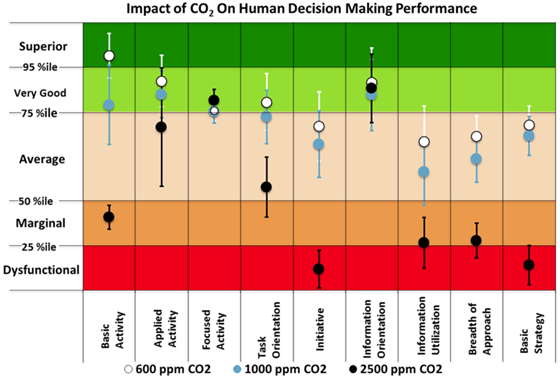This change in the chemical composition of the atmosphere has at least three consequences of major concern:
First, by absorbing heat radiated by the Earth to outer space, the carbon dioxide added to the atmosphere warms the planet, though by what amount is highly uncertain due to the complex interactions among climate variables.
Second, by increasing the efficiency with which plants use water in photosynthesis, it has increased global primary production by, according to some estimates, as much as ten billion tons per year. But not all plants respond to an increase in atmospheric carbon dioxide concentration in the same way, so that some species will increase in range and habitat dominance, while others will be at a competitive disadvantage. The net result will be the loss of many species both of plants and of the animals that depend on those plants for food or shelter.
Third, it appears from current research that rather small increases in atmospheric carbon dioxide concentration may severely impair certain important human cognitive capacities.
Combustion of fossil fuel (65-85% of total change).Conversion of old-growth forests to short-rotation plantations or bare land with the resultant atmospheric release of carbon fixed in both trees and forest soils (10-25% of total change).and the manufacture of cement, which involves the conversion of calcium carbonate to calcium oxide with the release of carbon dioxide (5% of total change).
 |
| Cooking with wood. Image source |
 |
| Old growth stump versus spindly second growth forest, British Columbia. Source |
First, the upgrading of industrial processes to achieve higher energy-use efficiencies. Gas turbine electricity generators, for example, can have an energy-use-efficiency at least 50% higher than most existing coal-fired plants.Second, the redesign of the human environment, including residential architecture and transportation systems, to eliminate the massive expenditures of time, capital and energy necessitated by the suburban/commuter life-style.Third, the redirection of consumption from energy intensive goods and services, such as airline travel, SUV's, and monster homes, to low-energy-content goods and services, including bicycles, and health, fitness, educational and religious services.
 |
| The efficient commuter. Image source |
Beside its direct effect on carbon emissions, the carbon tax has two other important features.
First, it will drive increases in carbon-use efficiency in the most cost effective way. Those who can reduce their emissions for less than the cost of the carbon tax will do so, whereas those who cannot reduce their emissions for less than the cost of the carbon tax will pay the tax and continue emitting, though at a reduced rate as the cost of what they sell is raised as a consequence of the carbon tax. Thus will be achieved a reduction in emissions at the lowest overall cost to the economy, with scope for increasing the reduction indefinitely by increases in the carbon tax rate.Second, the effective application of a carbon tax can be undertaken by any jurisdiction without consultation or agreement with any other jurisdiction. There is no need for international agreement. All that is needed is a countervailing import tax on goods or services from countries without a carbon tax of comparable severity to one's own. Such a provision not only protects the home industry from unfair foreign competition, but provides other countries with an incentive to introduce their own carbon tax.
Sadly, the beauty of the carbon tax mechanism, which we spelled out eighteen years ago, has yet to be recognized by any national government. It is encouraging, however, that the new government of Canada has promised a national carbon tax, although the value of such a measure will depend upon the details. There must be no exemptions for favored industries or regions and it must be accompanied by a countervailing import tax to protect Canadian jobs from unfair competition.
Related:
CanSpeccy: Rising Atmospheric Carbon Dioxide Concentration, Part III: Induced Stupidity and the Decline of the West
CanSpeccy: Rising Atmospheric Carbon Dioxide Concentration, Part II: Ecosystem Disruption
CanSpeccy: Rising Atmospheric Carbon Dioxide Concentration, Part I: Carbon Dioxide Is Not a Greenhouse Gas
